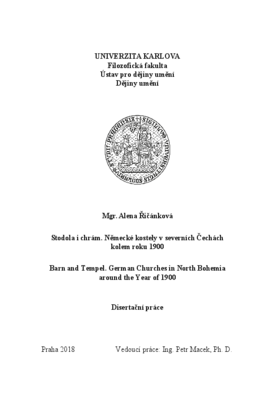Stodola i chrám. Německé kostely v severních Čechách kolem roku 1900
Barn and Tempel. German Churches in North Bohemia around the Year of 1900
dizertační práce (OBHÁJENO)

Zobrazit/
Trvalý odkaz
http://hdl.handle.net/20.500.11956/103831Identifikátory
SIS: 104738
Kolekce
- Kvalifikační práce [24991]
Autor
Vedoucí práce
Oponent práce
Petrasová, Taťána
Nešpor, Zdeněk
Fakulta / součást
Filozofická fakulta
Obor
Dějiny výtvarného umění
Katedra / ústav / klinika
Ústav pro dějiny umění
Datum obhajoby
18. 9. 2018
Nakladatel
Univerzita Karlova, Filozofická fakultaJazyk
Čeština
Známka
Prospěl/a
Klíčová slova (česky)
Severní Čechy|Sasko|architektura|konfese|kostel|stavební styl|liturgie|katolická církev|evangelická církev|starokatolická církev|Los von RomKlíčová slova (anglicky)
North Bohemia|Saxony|architecture|konfession|church|building style|liturgy|katholic church|evangelic church|oldcatholic church|Los von Rom (Away from Rome)Ačkoli je pro oblast severních Čech charakteristický především průmyslový boom druhé poloviny 19. století, který místní krajinu a města nenávratně proměnil, vznikaly zde kolem roku 1900 také stavby ryze tradičního charakteru, totiž kostely. V jejich hmotovém řešení i stylovém pojetí se mísí vliv dobového architektonického vývoje, individuálního vtisku architektů, stejně jako liturgických požadavků jednotlivých vyznání a konkrétních představ stavebníků. O podobě ideálního kostela, a to jak ve smyslu funkčním a vizuálním, tak i ve smyslu jeho významů symbolických, se v dané době vedly četné debaty a polemiky, vznikla řada teoretických textů i stavebních regulativů. Předložená práce sleduje především uplatnění moderních architektonických prvků na ryze tradičním stavebním kostelním typu. Činí tak především na základě srovnání psané teorie a stavitelské praxe. Danou diskuzí se zabývám u katolíků, starokatolíků a především pak u evangelických vyznání, u nichž je báze teoretických textů nejširší a kostelní novostavby nejčetnější. Téma úzce souvisí také s otázkami národnostními, s pozicí a rolí německého obyvatelstva na území severních Čech a se zásadními vlivy, které sem přicházely ze sousedního Saska, ať už ve formě finanční podpory novostaveb kostelů či architektonických návrhů saských architektů.
Although the North Bohemian region is mainly associated with the industrial rise of the second half of the nineteenth century, which altered the local scenery and cities irreversibly, there were also far more traditional constructions being built around 1900, such churches. Between their solid-state and period concept is blended the influence of the authentic architectural progression, individual impress of architects, furthermore liturgical requirements of particular beliefs and concrete visions of owner-builders. Back then the ideal image of a church was seen as the root of discussion and polemic when many theoretical texts and building regulations were originated. The submitted work observes mainly the use of modern architectonic components following authentically traditional church architecture type. It is done pre-eminently, based on written theory and architectural practices confrontation. The given discussion I pursue with Catholics, Old-Catholics and mainly with Evangelical Confessions, whose base of theoretical text is the widest and newly build churches the most numerous. The subject given is closely related to national questions, situation and purpose of the German inhabitants resided in the territory of North Bohemia. As well as to fundamental influences that were coming here from neighboring...
